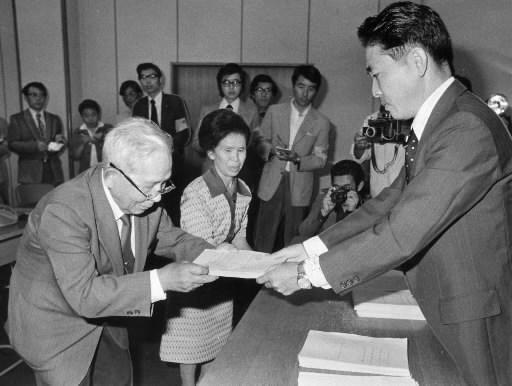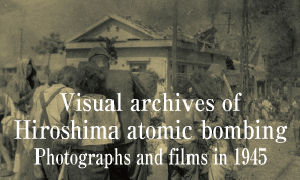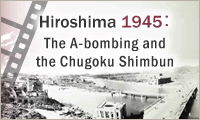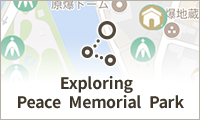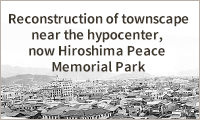My Life: Interview with TV Director Yasuko Isono, Part 9
Jun. 26, 2013
Entering the World of Television
by Takahiro Yamase, Staff Writer
Confidence grows covering the “Katoro Case”
While I was making a mark in radio, one of the male TV directors was transferred. When I asked to take over his role, no one was opposed. Finally, then, I had arrived in the television section. For my first TV documentary, I chose the theme that I had been covering during my stint in radio: the Yamaguchi Prefectural Welfare Hall for A-bomb Survivors, known as Yuda-en and located in the city of Yamaguchi. [Today, the organization goes by the name of Yamaguchi Prefectural Social Welfare Center for A-bomb Survivors.]
In her program titled “Kono Inori O” (“With A Prayer”), broadcast in August 1971, she covered the late Hatsuma Nagamatsu, the former executive director of Yuda-en.
A quarter of a century had passed since the war, and the existence of A-bomb survivors was far away from the thoughts of the people of Yamaguchi. It was difficult to inspire citizens to become involved in efforts for peace. Under such circumstances, Yuda-en, which was established by university professors and students who had had no personal connection to the atomic bombing, struggled valiantly on its own. As someone in the media, I would often go there to be of some support.
Mr. Nagamatsu had experienced the bombing in Hiroshima and suffered from guilt, feeling he had deserted children who were crying out for help. As a result, he was determined to help support the peace activities of A-bomb survivors living in Yamaguchi. In my program, I showed the depth of his engagement, even staying nights at Yuda-en. I wanted the citizens of Yamaguchi to see that the Hiroshima bombing impacted them, too, and I proposed ways for ordinary people to get involved.
In 1976, her documentary “Aru Shunen: Hirakuka Saishin no Michi” (“Tenacity for a Retrial”) was broadcast nationwide and it received the Outstanding Performance Award in the TV Social Program Category for the National Association of Commercial Broadcasters in Japan Award (NAB Award).
The program looked at the “Katoro Case,” a well-known incident of false accusation. After serving a long prison sentence, for robbery and murder, Shinichi Kato an elderly man nicknamed “Old Kato,” appealed for his innocence six times in court. From newspaper coverage, I learned of his appeal for a retrial at the Hiroshima High Court in 1975. I then visited him at his home in Tonoshiki [present-day Toyota-cho, Shimonoseki City].
The interior of his house was just like the days of the old Taisho period (1912-1926), when the incident took place. There were no white electrical appliances, a symbol of the economic growth at the time of my visit. Mr. Kato made fires in a kitchen stove and washed his clothes with mountain water from a bamboo pipe. Branded as a criminal, it was plain that he was isolated from the people around him. When I met with him, he spoke eloquently for three hours. He was angry at his fate and I felt moved to cover his story to understand what had happened.
I spent many hours at the library, transcribing the newspaper articles from the Taisho period reporting on his case. I contacted a doctor to confirm information about a blood stain, which had been the focus of deliberation at his trial. Just prior to the decision regarding his retrial, I broadcast the facts I had found. Creating a program that could help reverse the original ruling was a real challenge.
This program was my first nationwide broadcast, so I asked Toshio Ikematsu (who won the Japan National Press Club Award in fiscal 1976), a director at an affiliated station, to preview my work before it aired. When Mr. Ikematsu told me, “I have no advice to give you,” his endorsement made me feel that I could do good work in TV, too.
(Originally published on December 11, 2010)
by Takahiro Yamase, Staff Writer
Confidence grows covering the “Katoro Case”
While I was making a mark in radio, one of the male TV directors was transferred. When I asked to take over his role, no one was opposed. Finally, then, I had arrived in the television section. For my first TV documentary, I chose the theme that I had been covering during my stint in radio: the Yamaguchi Prefectural Welfare Hall for A-bomb Survivors, known as Yuda-en and located in the city of Yamaguchi. [Today, the organization goes by the name of Yamaguchi Prefectural Social Welfare Center for A-bomb Survivors.]
In her program titled “Kono Inori O” (“With A Prayer”), broadcast in August 1971, she covered the late Hatsuma Nagamatsu, the former executive director of Yuda-en.
A quarter of a century had passed since the war, and the existence of A-bomb survivors was far away from the thoughts of the people of Yamaguchi. It was difficult to inspire citizens to become involved in efforts for peace. Under such circumstances, Yuda-en, which was established by university professors and students who had had no personal connection to the atomic bombing, struggled valiantly on its own. As someone in the media, I would often go there to be of some support.
Mr. Nagamatsu had experienced the bombing in Hiroshima and suffered from guilt, feeling he had deserted children who were crying out for help. As a result, he was determined to help support the peace activities of A-bomb survivors living in Yamaguchi. In my program, I showed the depth of his engagement, even staying nights at Yuda-en. I wanted the citizens of Yamaguchi to see that the Hiroshima bombing impacted them, too, and I proposed ways for ordinary people to get involved.
In 1976, her documentary “Aru Shunen: Hirakuka Saishin no Michi” (“Tenacity for a Retrial”) was broadcast nationwide and it received the Outstanding Performance Award in the TV Social Program Category for the National Association of Commercial Broadcasters in Japan Award (NAB Award).
The program looked at the “Katoro Case,” a well-known incident of false accusation. After serving a long prison sentence, for robbery and murder, Shinichi Kato an elderly man nicknamed “Old Kato,” appealed for his innocence six times in court. From newspaper coverage, I learned of his appeal for a retrial at the Hiroshima High Court in 1975. I then visited him at his home in Tonoshiki [present-day Toyota-cho, Shimonoseki City].
The interior of his house was just like the days of the old Taisho period (1912-1926), when the incident took place. There were no white electrical appliances, a symbol of the economic growth at the time of my visit. Mr. Kato made fires in a kitchen stove and washed his clothes with mountain water from a bamboo pipe. Branded as a criminal, it was plain that he was isolated from the people around him. When I met with him, he spoke eloquently for three hours. He was angry at his fate and I felt moved to cover his story to understand what had happened.
I spent many hours at the library, transcribing the newspaper articles from the Taisho period reporting on his case. I contacted a doctor to confirm information about a blood stain, which had been the focus of deliberation at his trial. Just prior to the decision regarding his retrial, I broadcast the facts I had found. Creating a program that could help reverse the original ruling was a real challenge.
This program was my first nationwide broadcast, so I asked Toshio Ikematsu (who won the Japan National Press Club Award in fiscal 1976), a director at an affiliated station, to preview my work before it aired. When Mr. Ikematsu told me, “I have no advice to give you,” his endorsement made me feel that I could do good work in TV, too.
(Originally published on December 11, 2010)

